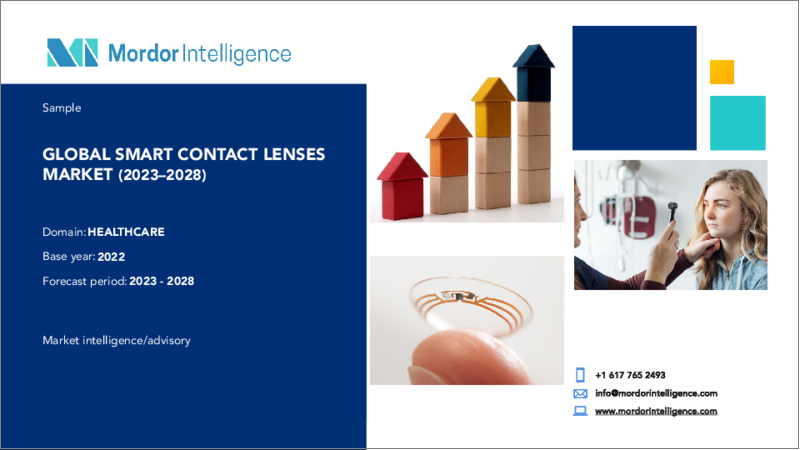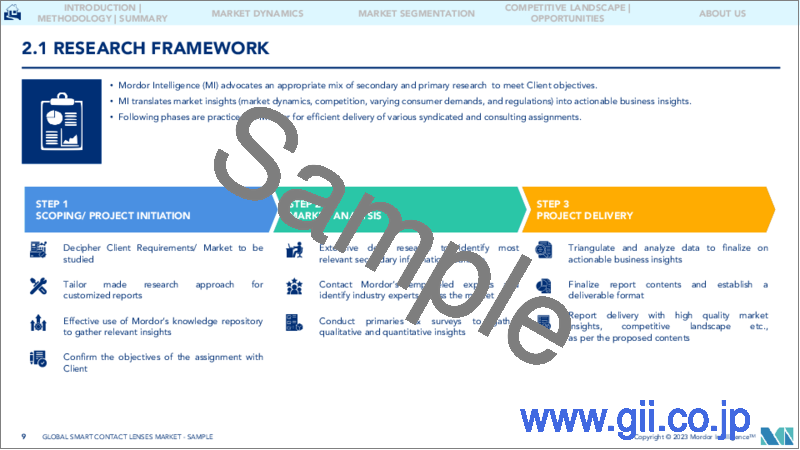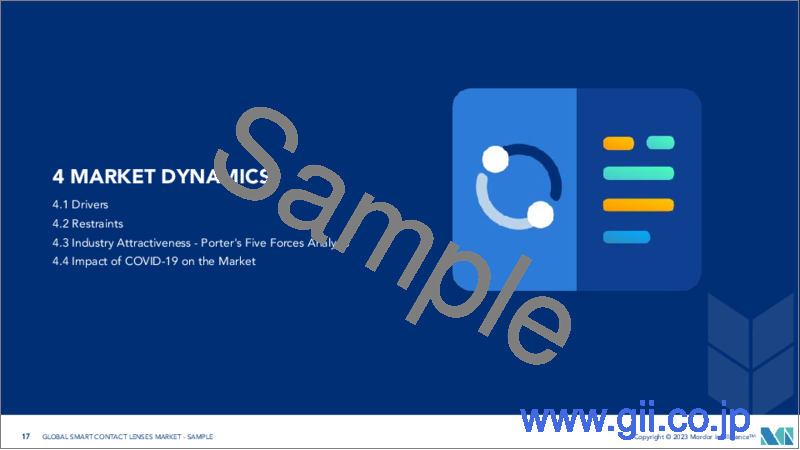|
|
市場調査レポート
商品コード
1198361
スマートコンタクトレンズ市場- 成長、動向、予測(2023年~2028年)Smart Contact Lenses Market - Growth, Trends, and Forecasts (2023 - 2028) |
||||||
|
● お客様のご希望に応じて、既存データの加工や未掲載情報(例:国別セグメント)の追加などの対応が可能です。 詳細はお問い合わせください。 |
|||||||
| スマートコンタクトレンズ市場- 成長、動向、予測(2023年~2028年) |
|
出版日: 2023年01月23日
発行: Mordor Intelligence
ページ情報: 英文 111 Pages
納期: 2~3営業日
|
- 全表示
- 概要
- 目次
スマートコンタクトレンズ市場は、予測期間である2022年から2027年にかけてCAGR9.8%を記録すると予測されています。
スマートコンタクトレンズ市場の成長に対するCOVID-19の影響は、眼科受診の減少により2020年には不利となっています。例えば、疾病管理予防センターと米国眼科学会が2020年8月に発表したデータによると、眼科の受診は当初80%近く減少していました。6月中旬の時点でも、米国では眼科受診が累計で4割ほど減少しています。しかし、世界的に眼科診療が再開されつつあることから、近い将来、通常の成長率に戻る可能性があります。例えば、2020年6月にインドで発表された記事「Tele-consultations in the wake of COVID-19-Suggested guidelines for clinical ophthalmology」によると、保健家族福祉省は、眼科医療施設が患者の訪問を減らすために遠隔カウンセリングと遠隔相談を奨励し、予約システムに従って検査、眼の調査、または処置を必要とする患者に電話をかけられるようにすべきなど、COVID-19シナリオにおける安全な眼科診療に関するガイドラインを提案しています。同様に、2020年3月には、米国眼科学会(AAO)が、眼科医に対して緊急・救急医療以外の診療を中止するよう勧告する診療ガイドラインを発表しています。このような要因により、患者層におけるスマートコンタクトレンズの需要が高まり、今後数年間の市場成長につながると予測されます。
さらに、市場の成長を促進する主な要因として、眼科疾患の負担増、老年人口における老眼の普及率の増加、緑内障治療技術の進歩の急増、スマートコンタクトレンズ製造のための主要な市場関係者による研究開発活動の活発化などが挙げられます。
スマートコンタクトレンズは、涙に含まれるグルコースレベルを測定し、目の中の眼圧をモニターすることによって、糖尿病や緑内障を診断します。目の障害につながる糖尿病の負担増は、したがって、スマートコンタクトレンズの需要を促進し、それによって市場の成長に大きく貢献すると予想され、例えば、2021年11月発表の「Global Prevalence of Diabetic Retinopathy and Projection of Burden through 2045:Systematic Review and Meta-Analysis」と題する論文のように、糖尿病の個人の中で、世界有病率は22.27%でした。27%、視力を脅かすDR(VTDR)が6.17%、臨床的に重要な黄斑浮腫が4.07%となっています。また、2021年7月に発表された「Prevalence of primary open-angle glaucoma in the last 20 years:a meta-analysis and systematic review」と題する論文の通り、過去20年間の原発開放隅角緑内障(POAG)の最新の世界有病率が示されました。この研究結果によると、40歳以上の人口におけるPOAGの世界全体の有病率は2.4%です。さらに、2022年3月の最新情報によると、韓国では、ハン・セイクァン教授と博士候補のイ・ゴンヒ博士が率いるPOSTECH研究チームが、PHI BIOMED社のシン・サンバイ博士と共同で、120μW遠赤・LED光を網膜に照射して糖尿病網膜症を予防、早期治療するスマートコンタクトレンズ型ウェアラブル端末を開発したとのことです。このスマートLEDコンタクトレンズの技術は、様々な眼科疾患に対して大きな注目を集めています。
したがって、上記の要因から、眼科疾患の負担の増大とスマートコンタクトレンズ技術の進歩が、予測期間においてスマートコンタクトレンズの需要を牽引するものと思われます。
しかし、スマートコンタクトレンズのコストが高いことや、スマートコンタクトレンズに関する認知度の低さが、市場の成長を抑制する主な要因となっています。
スマートコンタクトレンズの市場動向
スマートコンタクトレンズ市場では、連続グルコースモニタリングセグメントが大きな市場シェアを占める見込み
アプリケーション別では、連続グルコースモニタリングセグメントが市場で大きなシェアを占めると予想されます。スマートコンタクトレンズは、涙に含まれるグルコースレベルを継続的に測定することで、糖尿病患者を支援することを目的としています。小型化されたセンサーと無線チップがこれらのレンズに組み込まれ、糖尿病患者の眼圧などの生理的要因を追跡します。センサーは、ソフトレンズの2つの層に埋め込まれています。外側の層にある小さな開口部から涙がセンサーに流れ込み、センサーが血糖値を検知してデータをワイヤレスデバイスに送信して保存します。このように、グルコースレベルをリアルタイムで監視することで、食事や身体活動、医薬品のバランスを考慮した日々の意思決定を支援することができます。
この分野の成長を促進する主な要因は、研究開発活動の増加、眼科分野の技術的進歩、糖尿病患者の間でスマートコンタクトレンズの採用が拡大していることなどです。2021年6月に発表された「Current Approaches and Future Perspectives」によると、最近のバイオメディカル目的のスマートコンタクトレンズの開発は、糖尿病性網膜症の治療のための連続グルコースモニタリングとオンデマンドの柔軟なドラッグデリバリーシステムの両方を兼ね備えているそうです。
また、研究開発活動の活発化も、このセグメントの成長に寄与しています。例えば、「糖尿病診断と治療のためのワイヤレススマートコンタクトレンズ」と題された2020年4月発行の記事によると、研究者は、連続グルコースモニタリングと糖尿病性網膜症の治療のためのスマートコンタクトレンズを開発したとのことです。この研究によると、生体適合性ポリマー上に構築されたスマートコンタクトレンズ装置には、超薄型で柔軟な電気回路、およびリアルタイム電気化学バイオセンシング、オンデマンド制御ドラッグデリバリー、ワイヤレス電力管理、およびデータ通信用のマイクロコントローラチップが含まれています。さらに、このデバイスは、従来の侵襲的な血糖値検査で検証される涙液グルコースレベルを測定することができるとしています。このような研究は、持続的なグルコースモニタリングにおけるスマートコンタクトレンズの重要性を強調しています。このように、肯定的な結果を伴うより多くの研究が製品承認につながり、ひいては今後一定期間のセグメントの成長に寄与しています。
したがって、上記の開発により、このセグメントは予測期間中に大きな成長を示すことが期待されます。
世界市場において北米が最大のシェアを占める見込み
北米は、市場において大きなシェアを占めると予想されます。これは、眼科治療を求める患者の訪問数の増加、製品の市販に関する意識の高まり、研究開発活動の増加、同地域における市場プレイヤーの強い存在感などの要因に起因すると考えられます。
例えば、BrightFocus Foundationによる2021年7月の更新によると、300万人以上のアメリカ人が緑内障を患っており、そのうち40歳以上の270万人がその最も一般的な形態である開放隅角緑内障に罹患しているとのことです。また、米国では、アフリカ系アメリカ人とヒスパニック系アメリカ人の失明原因のトップが緑内障であるとされています。したがって、緑内障を患う人々の数が多いことから、この地域ではスマートコンタクトレンズの需要が高まり、最終的に市場の成長に貢献するものと思われます。
さらに、著名なプレーヤーが行っているいくつかの戦略的イニシアティブも、市場の成長に寄与しています。例えば、2021年1月、ハイドロゲルデバイスへのマイクロエレクトロニクス技術の埋め込みを専門とする企業であるInWithは、CESイベント2021で驚くべきスマートコンタクトレンズを実演し、ソフトコンタクトレンズにおける拡張現実(AR)のコンピュータ化アプリケーションの未来への新しい扉を開けました。
したがって、上記の要因によって、市場は予測期間中に大きな成長を示すことが期待されます。
スマートコンタクトレンズ市場の競合他社分析
スマートコンタクトレンズ市場は、複数の世界および国際的なプレーヤーが存在し、競争が激しくなっています。主要プレイヤーは、パートナーシップ、契約、協力、新製品の発売、地理的拡大、合併、買収など、市場での存在感を高めるためにさまざまな成長戦略を採用しています。市場の主要プレイヤーには、Sensimed、Mojo Vision、Innovega Inc.、InWith Corporation、Johnson &Johnsonなどの市場プレイヤーが挙げられます。
その他の特典
- エクセル形式の市場予測(ME)シート
- アナリストによる3ヶ月間のサポート
目次
第1章 イントロダクション
- 調査の前提条件と市場の定義
- 調査対象範囲
第2章 調査手法
第3章 エグゼクティブサマリー
第4章 市場力学
- 市場概要
- 市場促進要因
- 眼科疾患の負担増
- スマートコンタクトレンズの研究開発の増加
- 市場抑制要因
- スマートコンタクトレンズの高コストと認知度の低さ
- ポーターのファイブフォース分析
- 新規参入業者の脅威
- 買い手/消費者の交渉力
- 供給企業の交渉力
- 代替品の脅威
- 競争企業間の敵対関係
第5章 市場セグメンテーション(金額ベース市場規模:百万米ドル)
- タイプ別
- 硬質ガス透過性(RGP)
- デイリーウェアソフトレンズ
- 長期装用レンズ
- その他
- アプリケーション別
- 持続的グルコースモニタリング
- 持続的眼圧測定
- エンドユーザー別
- 病院
- 眼科クリニック
- その他のエンドユーザー
- 地域別
- 北米
- 欧州
- アジア太平洋地域
- 中東地域
- 南米
第6章 競合情勢
- 企業プロファイル
- Sensimed
- Mojo Vision
- Innovega Inc.
- InWith Corporation
- Johnson & Johnson
- Samsung
- Sony Group Corporation
- EP Global Communications Inc(EPGL)
- International Business Machines(IBM)Corporation
- Huawei Biomed
- RaayonNova LLC
第7章 市場機会と今後の動向
The Smart Contact Lenses Market is expected to register a CAGR of 9.8% over the forecast period, 2022-2027.
The impact of COVID-19 on the smart contact lenses market's growth was adverse in 2020 due to fewer eye care consultations. For instance, according to data published in August 2020 by the Centers for Disease Control and Prevention and the American Academy of Ophthalmology, there was a nearly 80% initial decrease in ophthalmology visits. As of mid-June, there was still a 40% cumulative decrease in ophthalmology visits in the United States. However, owing to the recommencement of ophthalmology practices and procedures worldwide, the market may soon prevail with a normal growth rate. For instance, according to the article "Tele-consultations in the wake of COVID-19 - Suggested guidelines for clinical ophthalmology," published in June 2020 in India, the Ministry of Health and Family Welfare proposed guidelines for safe ophthalmology practices in the COVID-19 scenario, such as eye care facilities should ensure that telecounseling and teleconsultation should be encouraged to reduce patient visits and appointment systems can be followed to call patients needing examinations, eye investigations, or procedures. Likewise, in March 2020, the American Academy of Ophthalmology (AAO) released practice guidelines advising ophthalmologists to cease providing any treatment other than urgent and emergent care. Such factors are projected to boost the demand for smart contact lenses among the patient population, thereby leading to market growth over the coming years.
Furthermore, the major factors fuelling the market's growth are the rising burden of eye disorders, the growing prevalence of presbyopia in the geriatric population, the surge in advancements in glaucoma treatment technologies, and the increasing research and development activities by key market players for smart contact lens manufacturing.
Smart contact lenses diagnose diabetes and glaucoma by measuring the glucose level in tears and monitoring intraocular pressure within the eyes. The rising burden of diabetes, leading to eye disorders, is thus expected to drive the demand for smart contact lenses, thereby significantly contributing to the market growth, for instance, as per a November 2021 published article titled, "Global Prevalence of Diabetic Retinopathy and Projection of Burden through 2045: Systematic Review and Meta-analysis", among individuals with diabetes, the global prevalence was 22.27% for diabetic retinopathy, 6.17% for vision-threatening DR (VTDR), and 4.07% for clinically significant macular edema. In addition, as per a July 2021 published article titled, "Prevalence of primary open-angle glaucoma in the last 20 years: a meta-analysis and systematic review", the study provided the most updated worldwide prevalence of primary open-angle glaucoma (POAG) for the last 20 years. As per the study results, the overall global prevalence of POAG in the population over 40 years old is 2.4%. Moreover, according to a March 2022 update, in South Korea, a POSTECH research team led by Professor Sei Kwang Hahn and Ph.D. candidate Geon-Hui Lee, in collaboration with Dr. Sangbaie Shin of PHI BIOMED Co., developed a smart contact lens-type wearable device to prevent diabetic retinopathy and treat it in its early stages by irradiating 120 µW far-red/LED light to the retina. This technology for smart LED contact lenses has attracted great attention for various ophthalmologic diseases.
Thus, the abovementioned factors indicate that the growing burden of eye disorders and advancements in smart contact lens technology will drive the demand for smart contact lenses over the forecast period.
However, the high cost of smart contact lenses and lack of awareness about these lenses are the major factors restraining the market's growth.
Smart Contact Lenses Market Trends
Continuous Glucose Monitoring Segment is Expected to Hold a Significant Market Share in the Smart Contact Lenses Market
By application, the continuous glucose monitoring segment is expected to hold a significant share in the market. The smart contact lens aims to help diabetes patients by continuously measuring the glucose level in their tears. Miniaturized sensors and wireless chips are built into these lenses to track physiological factors such as intraocular pressure in people with diabetes. Sensors are embedded in the two layers of soft lenses. A small opening in the outer layer allows tears to flow into the sensor, which detects blood sugar levels and transmits the data to the wireless device for storage. Thus, monitoring glucose levels in real-time aids in making informed daily decisions about balancing food, physical activity, and medicine.
The major factors fuelling the segment's growth are an increase in research and development activities, technological advancements in the field of ophthalmology, and the growing adoption of smart contact lenses among the diabetic population, for instance, as per an article titled "Continuous Non-Invasive Glucose Monitoring via Contact Lenses: Current Approaches and Future Perspectives" published in June 2021, recent advances in the development of smart contact lenses for biomedical purposes combine both continuous glucose monitoring with an on-demand flexible drug delivery system for the treatment of diabetic retinopathy.
In addition, increasing research and development activities contribute to the segment's growth. For instance, as per an April 2020 published article titled "Wireless smart contact lens for diabetic diagnosis and therapy," the researchers developed smart contact lenses for continuous glucose monitoring and treating diabetic retinopathy. As per the study, the smart contact lens device, built on a biocompatible polymer, contains ultrathin, flexible electrical circuits, and a microcontroller chip for real-time electrochemical biosensing, on-demand controlled drug delivery, wireless power management, and data communication. Additionally, the study states that the device could measure tear glucose levels to be validated by conventional invasive blood glucose tests. Such studies highlight the significance of smart contact lenses in continuous glucose monitoring. Thus, more studies with positive outcomes are leading to product approvals, which, in turn, contribute to the segment's growth over the coming period.
Thus, due to the abovementioned developments, the segment is expected to witness significant growth over the forecast period.
North America is Expected to Hold the Largest Share in the Global Market
North America is expected to hold a significant share of the market. It can be attributed to factors such as the increasing number of patient visits seeking eye care treatment, a surge in awareness regarding the commercial availability of products, a rising number of research and development activities, and the strong presence of market players in the region.
For instance, as per a July 2021 update by the BrightFocus Foundation, more than three million Americans are living with glaucoma, 2.7 million of whom aged 40 and older are affected by its most common form, open-angle glaucoma. As per the same source, glaucoma is a leading cause of blindness among African Americans and Hispanics in the United States. Thus, the high number of people suffering from glaucoma will likely increase the demand for smart contact lenses within the region, ultimately contributing to market growth.
Additionally, several strategic initiatives undertaken by prominent players are contributing to the market's growth. For instance, in January 2021, InWith, a corporation that specializes in the embedding of microelectronic technology in hydrogel devices, demonstrated its incredible smart contact lenses at the CES event 2021, opening a new door for the future of computerized applications for augmented reality (AR) in soft contact lenses.
Thus, owing to the abovementioned factors, the market is expected to witness significant growth over the forecast period.
Smart Contact Lenses Market Competitor Analysis
The smart contact lenses market is competitive with several global and international players. The key players are adopting different growth strategies to enhance their market presence, such as partnerships, agreements, collaborations, new product launches, geographical expansions, mergers, and acquisitions. Some of the key players in the market are Sensimed, Mojo Vision, Innovega Inc., InWith Corporation, and Johnson & Johnson, among other market players.
Additional Benefits:
- The market estimate (ME) sheet in Excel format
- 3 months of analyst support
TABLE OF CONTENTS
1 INTRODUCTION
- 1.1 Study Assumptions and Market Definition
- 1.2 Scope of the Study
2 RESEARCH METHODOLOGY
3 EXECUTIVE SUMMARY
4 MARKET DYNAMICS
- 4.1 Market Overview
- 4.2 Market Drivers
- 4.2.1 Rising Burden of Eye Disorders
- 4.2.2 Increasing Research and Development for Smart Contact Lenses
- 4.3 Market Restraints
- 4.3.1 High Cost of Smart Contact Lenses and Lack of Awareness
- 4.4 Porter's Five Forces Analysis
- 4.4.1 Threat of New Entrants
- 4.4.2 Bargaining Power of Buyers/Consumers
- 4.4.3 Bargaining Power of Suppliers
- 4.4.4 Threat of Substitute Products
- 4.4.5 Intensity of Competitive Rivalry
5 MARKET SEGMENTATION (Market Size by Value - USD million)
- 5.1 By Type
- 5.1.1 Rigid Gas-Permeable (RGP)
- 5.1.2 Daily-wear Soft Lenses
- 5.1.3 Extended-wear Lenses
- 5.1.4 Others
- 5.2 By Application
- 5.2.1 Continuous Glucose Monitoring
- 5.2.2 Continuous Intraocular Pressure Monitoring
- 5.3 By End User
- 5.3.1 Hospitals
- 5.3.2 Ophthalmology Clinics
- 5.3.3 Other End Users
- 5.4 Geography
- 5.4.1 North America
- 5.4.2 Europe
- 5.4.3 Asia-Pacific
- 5.4.4 Middle-East
- 5.4.5 South America
6 COMPETITIVE LANDSCAPE
- 6.1 Company Profiles
- 6.1.1 Sensimed
- 6.1.2 Mojo Vision
- 6.1.3 Innovega Inc.
- 6.1.4 InWith Corporation
- 6.1.5 Johnson & Johnson
- 6.1.6 Samsung
- 6.1.7 Sony Group Corporation
- 6.1.8 EP Global Communications Inc (EPGL)
- 6.1.9 International Business Machines (IBM) Corporation
- 6.1.10 Huawei Biomed
- 6.1.11 RaayonNova LLC




